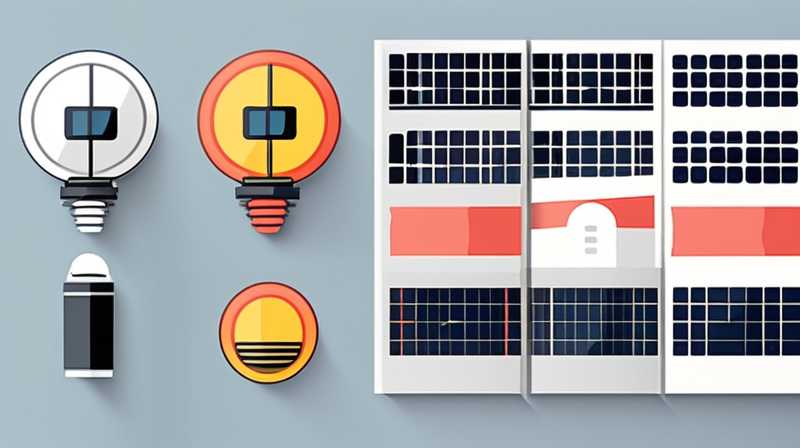
When a solar light has no power, assessing various components is crucial for understanding the issue. 1. Check the solar panel for obstructions, which may be preventing adequate sunlight exposure. 2. Inspect the battery to ensure it is properly connected and fully charged. 3. Examine the LED bulbs for any signs of damage. 4. Assess the wiring and connections for corrosion or loose ends, ensuring a stable power flow. Focusing on one aspect, the solar panel’s exposure to sunlight is vital; if it’s covered by dirt, debris, or shaded by surrounding objects, this could severely limit its ability to charge the battery adequately. Regular cleaning and strategic placement can prevent these issues, enhancing the solar light’s performance significantly.
1. UNDERSTANDING THE FUNCTIONALITY OF SOLAR LIGHTS
Solar lights operate using a combination of solar panels, batteries, and LEDs. These components work in unison to capture solar energy during the day and convert it to electrical power to illuminate spaces at night. Solar panels are essential; they absorb sunlight and convert it into electricity. This energy is then stored in rechargeable batteries.
The effectiveness of a solar light hinges on the smooth operation of all its components. For example, a malfunctioning solar panel will directly impact the battery’s charge, thereby affecting the LED functionality. If the solar panel receives inadequate sunlight, the battery may not charge sufficiently, resulting in diminished or absent light output.
2. COMMON REASONS FOR SOLAR LIGHT FAILURE
Several factors may lead to a solar light failing to work effectively. Understanding these can aid in troubleshooting.
One major reason is poor sunlight exposure. This can occur due to geographic location, seasonal changes, or physical obstructions such as trees or buildings that block sunlight. Over time, dirt and debris can accumulate on the solar panel, severely limiting solar absorption. Regular maintenance, including cleaning the panels, can significantly enhance their efficacy.
Another frequent cause of failure relates to battery issues. Batteries can degrade over time due to many factors, including temperature fluctuations and improper charging practices. If a battery remains discharged for an extended period, it may reach a state where it can no longer hold a charge, thus preventing the solar light from operating. Testing the battery and replacing it if necessary is an often overlooked but critical step in maintaining solar lights.
3. SOLVING POWER ISSUES IN SOLAR LIGHTS
When encountering power issues, a systematic approach is necessary.
Initially, inspect the solar panel for damage or obstructions. To maximize performance, ensure it is cleaned regularly. When cleaning, use a soft cloth to remove any accumulated grime or dirt that could impede solar absorption.
Next, check the battery connection. Ensure that terminals are free from corrosion and securely connected. A multimeter can be useful to ascertain whether the battery is holding a charge. If the battery fails to hold a charge, consider replacing it with a compatible unit.
4. TROUBLESHOOTING LEDs AND WIRING
After addressing the solar panel and battery, focus on inspecting the LED components.
LEDs can fail due to age or manufacturing defects. It is essential to verify the operational status of the bulbs; if any show signs of damage, such as flickering or failure to light, replace them promptly.
Wiring checks are also critical. Examine all connectors and wires for potential damage. Corrosion or loose connections can interrupt the power flow, resulting in diminished light output. Repairing any damaged wiring or connections is vital for restoring functionality.
FREQUENTLY ASKED QUESTIONS
WHY IS MY SOLAR LIGHT NOT TURNING ON AT NIGHT?
Solar lights rely heavily on their battery system for nighttime illumination. If your solar light isn’t turning on, the battery may be discharged or malfunctioning. First, verify that the solar panel received adequate sunlight throughout the day—if it didn’t, the stored power may not be sufficient for nighttime functionality. Additionally, inspect both the battery and the LED bulbs, as either could affect performance.
HOW OFTEN SHOULD I CLEAN MY SOLAR PANELS?
Typically, it is advisable to clean solar panels every three to six months, but environmental factors can necessitate more frequent cleaning. For instance, if you live in an area with frequent rainfall, dust, or pollen accumulation, cleaning may be required monthly. Maintaining clear, unobstructed solar panels is crucial for maximizing energy absorption throughout the day, ensuring optimal performance.
CAN I USE REGULAR BATTERIES WITH MY SOLAR LIGHT?
Using regular batteries in solar lights is generally not recommended. Solar lights are designed to work with rechargeable batteries, which allow for effective charging during sunlight exposure. Regular batteries may not withstand frequent charge-discharge cycles, leading to increased costs and environmental concerns due to battery disposal. Always opt for batteries specifically designed for solar devices for optimal performance.
In summary, it is essential to adopt a comprehensive perspective when addressing issues related to solar lights lacking power. By following systematic procedures to diagnose and rectify potential faults, users can ensure extended usability and efficiency of their solar lighting systems. Regular maintenance, including cleaning the solar panels and checking battery health, significantly contributes to performance improvement. Moreover, understanding each component’s functionality and its interdependence will facilitate better resolution of issues as they arise, leading to a more satisfying experience with solar technology. Keeping an eye on environmental factors and component wear and tear will aid in prolonging the operational lifespan of solar lights, ensuring they remain a reliable source of illumination for years to come. Solar energy not only contributes to sustainability but can also be a practical and cost-effective solution for outdoor lighting needs—provided the user is vigilant about maintenance and prompt in troubleshooting issues when they arise.
Original article by NenPower, If reposted, please credit the source: https://nenpower.com/blog/what-to-do-if-the-solar-light-has-no-power/


